SUZUKI GRAND VITARA 1987 Service Repair Manual
Manufacturer: SUZUKI, Model Year: 1987, Model line: GRAND VITARA, Model: SUZUKI GRAND VITARA 1987Pages: 962, PDF Size: 27.87 MB
Page 171 of 962
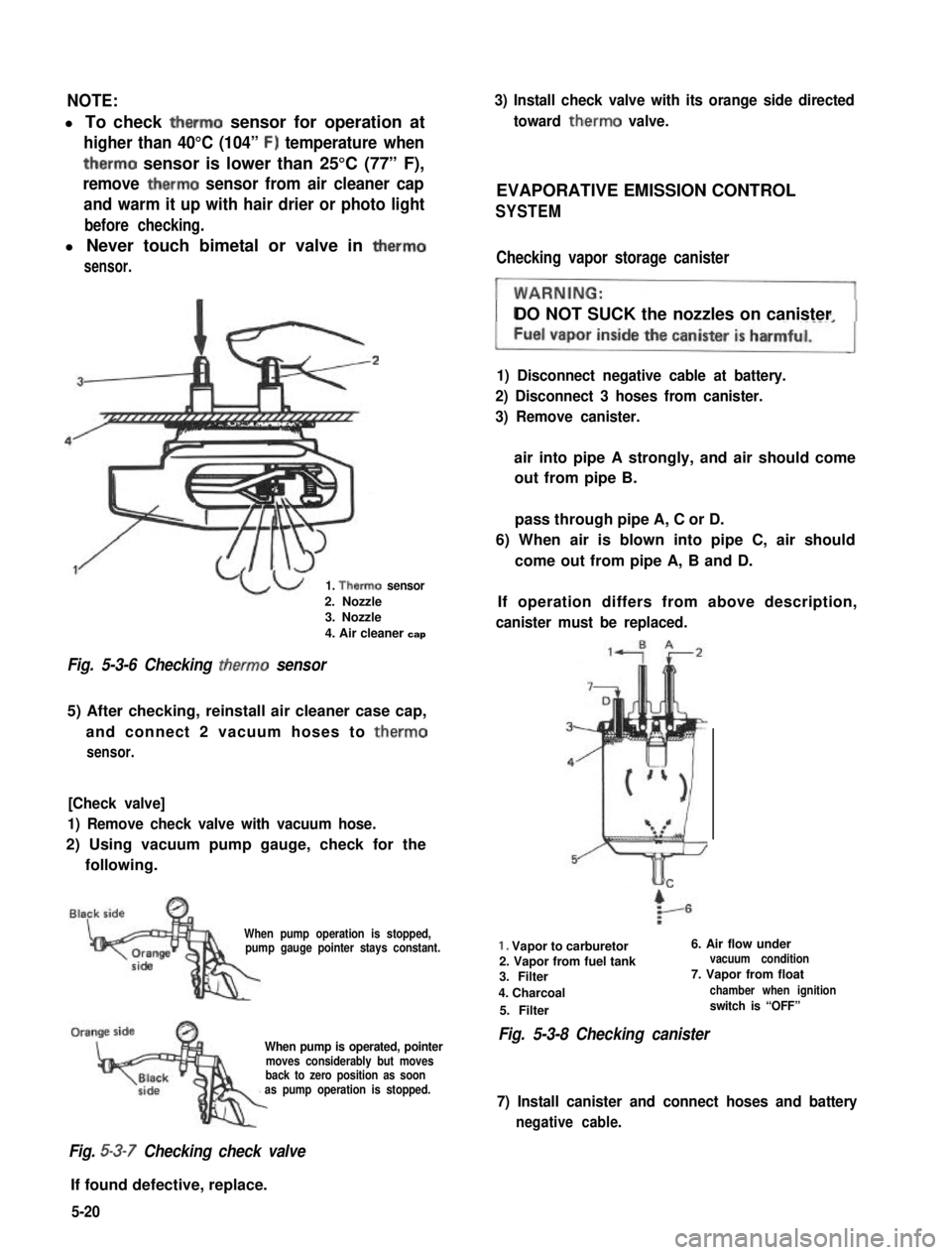
NOTE:
l To check therm0 sensor for operation at
higher than 40°C (104” F) temperature when
therm0 sensor is lower than 25°C (77” F),
remove therm0 sensor from air cleaner cap
and warm it up with hair drier or photo light
before checking.
l Never touch bimetal or valve in therm0
sensor.
1. Therm0 sensor
2. Nozzle3. Nozzle
4. Air cleaner cap
Fig. 5-3-6 Checking therm0 sensor
5) After checking, reinstall air cleaner case cap,
and connect 2 vacuum hoses to therm0
sensor.
[Check valve]
1) Remove check valve with vacuum hose.
2) Using vacuum pump gauge, check for the
following.
When pump operation is stopped,pump gauge pointer stays constant.
When pump is operated, pointermoves considerably but movesback to zero position as soonas pump operation is stopped.
Fig. 5-3-7 Checking check valve
If found defective, replace.
3) Install check valve with its orange side directed
toward therm0 valve.
EVAPORATIVE EMISSION CONTROL
SYSTEM
Checking vapor storage canister
DO NOT SUCK the nozzles on canister
1) Disconnect negative cable at battery.
2) Disconnect 3 hoses from canister.
3) Remove canister.
air into pipe A strongly, and air should come
out from pipe B.
pass through pipe A, C or D.
6) When air is blown into pipe C, air should
come out from pipe A, B and D.
If operation differs from above description,
canister must be replaced.
1. Vapor to carburetor6. Air flow under
2. Vapor from fuel tankvacuum condition
3. Filter7. Vapor from float
4. Charcoalchamber when ignition
5. Filterswitch is “OFF”
Fig. 5-3-8 Checking canister
7) Install canister and connect hoses and battery
negative cable.
5-20
Page 172 of 962
![SUZUKI GRAND VITARA 1987 Service Repair Manual [Hoses]
Visually inspect hoses and pipe for cracks,
damage, or excessive bends, and hose connec-
tion for tightness.
Fig. 5-3-9
HOT IDLE COMPENSATOR (HIC)
Checking Hot Idle Compensator
1) Remove air i SUZUKI GRAND VITARA 1987 Service Repair Manual [Hoses]
Visually inspect hoses and pipe for cracks,
damage, or excessive bends, and hose connec-
tion for tightness.
Fig. 5-3-9
HOT IDLE COMPENSATOR (HIC)
Checking Hot Idle Compensator
1) Remove air i](/img/20/57437/w960_57437-171.png)
[Hoses]
Visually inspect hoses and pipe for cracks,
damage, or excessive bends, and hose connec-
tion for tightness.
Fig. 5-3-9
HOT IDLE COMPENSATOR (HIC)
Checking Hot Idle Compensator
1) Remove air intake case with hose.
2) Check temperature around HIC with thermo-
meter.
3) If temperature is below 45°C (113” F), air
should not come out of HIC when air is
blown into hose. If temperature is above
65°C (149” F), air comes out of HIC.
Replace H IC if defective.
4) After checking, install air intake case and
connect hose to intake manifold.
NOTE:
l To check HIC for operation at higher than
65°C (149°F) temperature when HIC (bi-
metal) temperature is lower than 45°C
(113”F), warm it up with hair drier or photo
light before checking.
l Never touch bimetal or valve in HIC.
1
Below 45°C (113’F)Above 65’C (149’F)
Fig.5-i- 10
DECELERATION MIXTURE CONTROL
SYSTEM
Checking
[Hoses]
Inspect each hose for pinholes, cracks or damage.
Also check to ensure that each joint is securely
connected. Any part found defective must be
corrected or replaced.
.
Fig. 5-3- 11
[Mixture control valve (MCV)]
1) Warm up the engine to normal operating
temperature.
2) Disconnect hose @ and reconnect it. At this
time, check that air is drawn into MCV.
NOTE:
At this time, the engine will idle rough or die,
but this is normal.
A piece of paper
If the above checks show anything wrong,
replace it.
5-21
Page 173 of 962
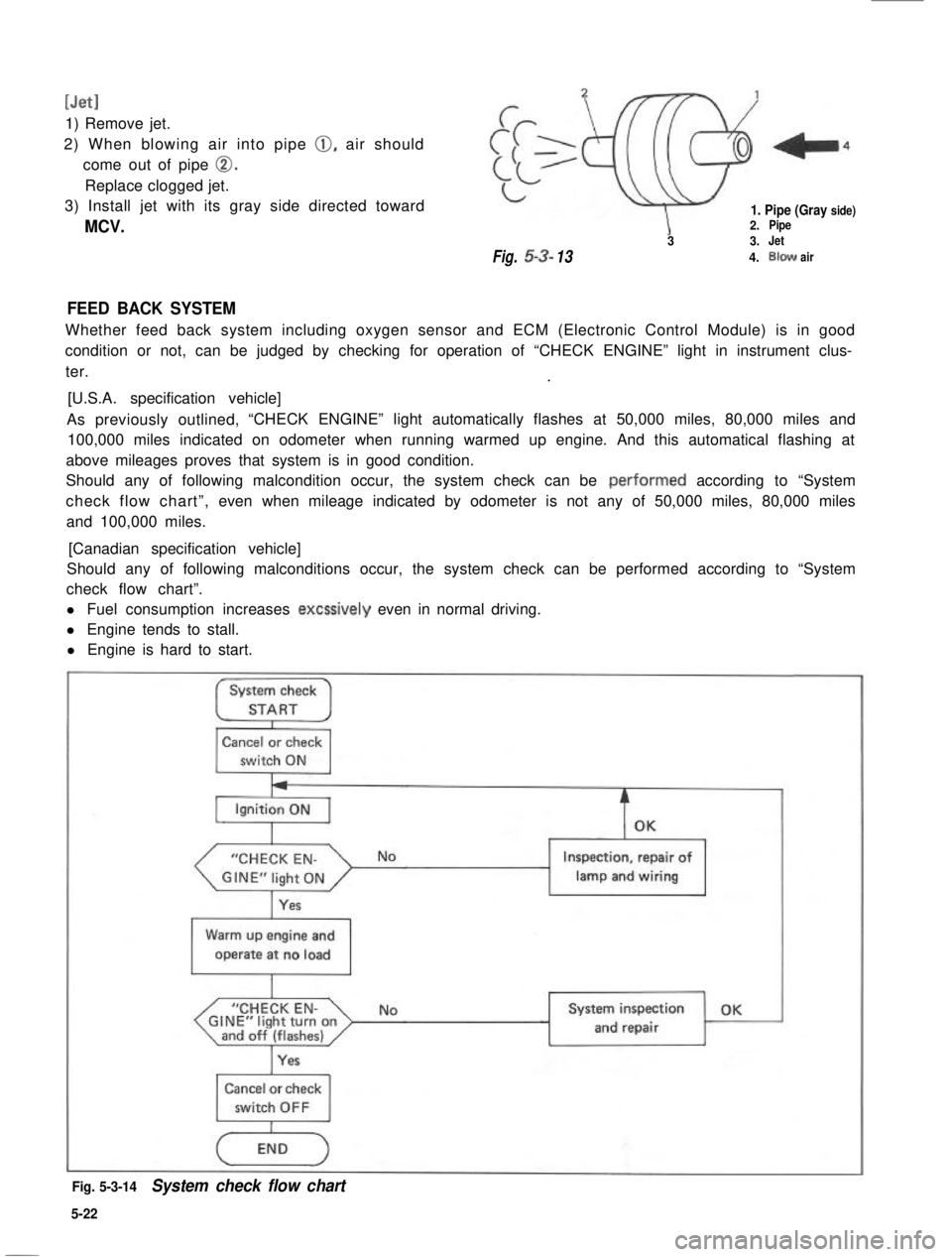
[Jet1
1) Remove jet.
2) When blowing air into pipe 0, air should
come out of pipe 0.
Replace clogged jet.
3) Install jet with its gray side directed toward
MCV.
1. Pipe (Gray side)2.Pipe
33.Jet
Fig.53-134.Blowair
FEED BACK SYSTEM
Whether feed back system including oxygen sensor and ECM (Electronic Control Module) is in good
condition or not, can be judged by checking for operation of “CHECK ENGINE” light in instrument clus-
ter..
[U.S.A. specification vehicle]
As previously outlined,“CHECK ENGINE” light automatically flashes at 50,000 miles, 80,000 miles and
100,000 miles indicated on odometer when running warmed up engine. And this automatical flashing at
above mileages proves that system is in good condition.
Should any of following malcondition occur, the system check can be .performed according to “System
check flow chart”,even when mileage indicated by odometer is not any of 50,000 miles, 80,000 miles
and 100,000 miles.
[Canadian specification vehicle]
Should any of following malconditions occur, the system check can be performed according to “System
check flow chart”.
l Fuel consumption increases excssively even in normal driving.
l Engine tends to stall.
l Engine is hard to start.
System check
STARTI
Cancel or check
switch ON
“CHECK EN-
Yes
Inspection, repair of
lamp and wiring1
Warm up engine and
operate at no load
I
“CHECK EN-GINE”light turnonand off (flashes)I
NoSystem inspection OK
and repair
Cancel or check
Fig. 5-3-14System check flow chart
5-22
Page 174 of 962
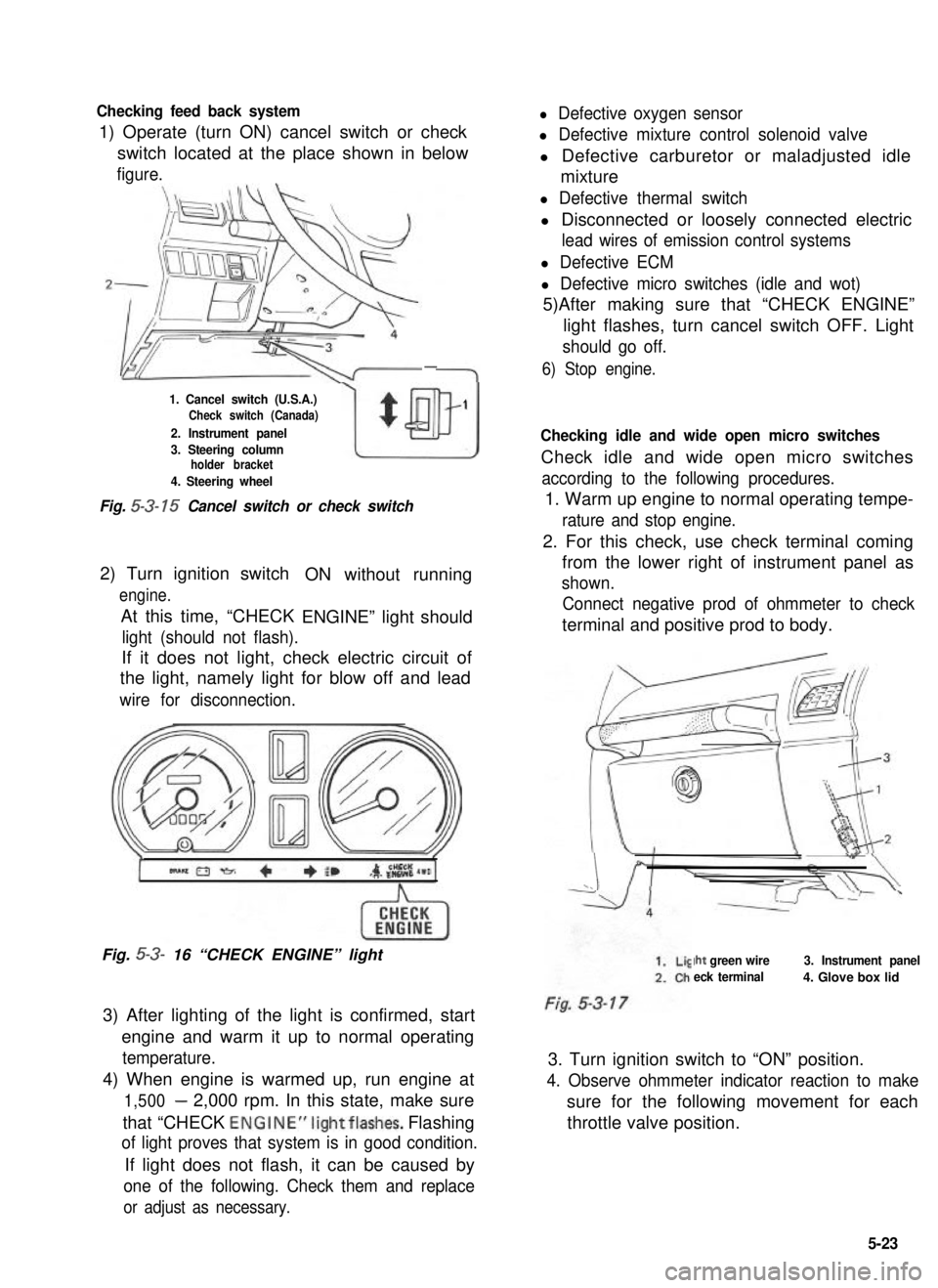
Checking feed back system
1) Operate (turn ON) cancel switch or check
l Defective oxygen sensor
l Defective mixture control solenoid valve
switch located at the place shown in belowl Defective carburetor or maladjusted idle
figure.mixture
-
1. Cancel switch (U.S.A.)Check switch (Canada)
2. Instrument panel
w
$
1
3. Steering columnholder bracket
4. Steering wheel
Fig. 5-3- 15 Cancel switch or check switch
2) Turn ignition switch
engine.
At this time, “CHECK
ON without running
ENGINE” light should
light (should not flash).
If it does not light, check electric circuit of
the light, namely light for blow off and lead
wire for disconnection.
Fig. 5-3- 16 “CHECK ENGINE” light
3) After lighting of the light is confirmed, start
engine and warm it up to normal operating
temperature.
4) When engine is warmed up, run engine at
1,500- 2,000 rpm. In this state, make sure
that “CHECK ENGINE”lightflashes. Flashing
of light proves that system is in good condition.
If light does not flash, it can be caused by
one of the following. Check them and replace
or adjust as necessary.
l Defective thermal switch
l Disconnected or loosely connected electric
lead wires of emission control systems
l Defective ECM
l Defective micro switches (idle and wot)
5)After making sure that “CHECK ENGINE”
light flashes, turn cancel switch OFF. Light
should go off.
6) Stop engine.
Checking idle and wide open micro switches
Check idle and wide open micro switches
according to the following procedures.
1. Warm up engine to normal operating tempe-
rature and stop engine.
2. For this check, use check terminal coming
from the lower right of instrument panel as
shown.
Connect negative prod of ohmmeter to check
terminal and positive prod to body.
Iht green wire
eck terminal
3. Instrument panel
4. Glove box lid
3. Turn ignition switch to “ON” position.
4. Observe ohmmeter indicator reaction to make
sure for the following movement for each
throttle valve position.
5-23
Page 175 of 962
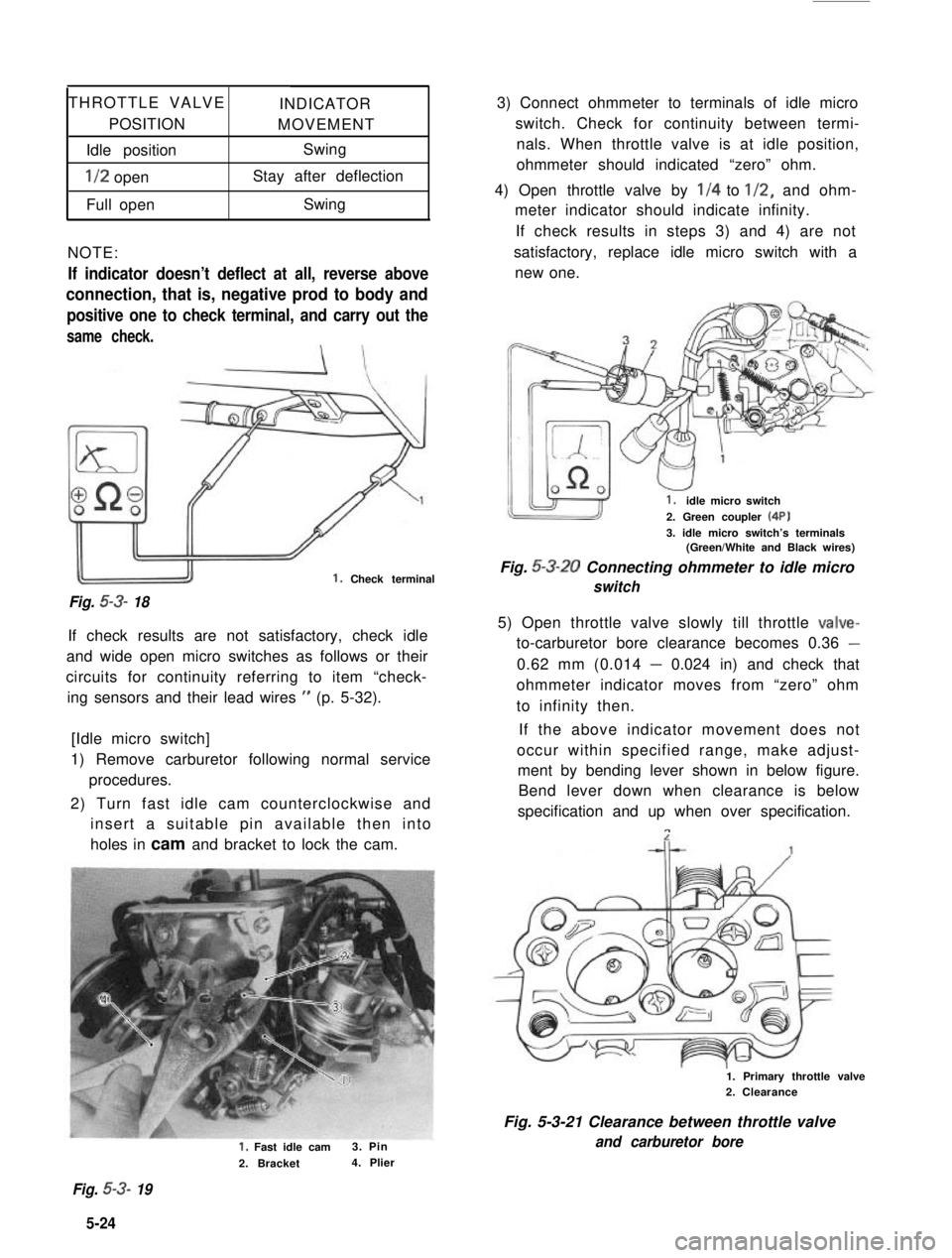
THROTTLE VALVEINDICATOR
POSITIONMOVEMENT
Idle positionSwing
l/2 openStay after deflection
Full openSwing
NOTE:
If indicator doesn’t deflect at all, reverse above
connection, that is, negative prod to body and
positive one to check terminal, and carry out the
same check.
Fig. 53- 18
1. Check terminal
If check results are not satisfactory, check idle
and wide open micro switches as follows or their
circuits for continuity referring to item “check-
ing sensors and their lead wires ” (p. 5-32).
[Idle micro switch]
1) Remove carburetor following normal service
procedures.
2) Turn fast idle cam counterclockwise and
insert a suitable pin available then into
holes in cam and bracket to lock the cam.
1, Fast idle cam3. Pin
2. Bracket4. Plier
3) Connect ohmmeter to terminals of idle micro
switch. Check for continuity between termi-
nals. When throttle valve is at idle position,
ohmmeter should indicated “zero” ohm.
4) Open throttle valve by l/4 to l/2, and ohm-
meter indicator should indicate infinity.
If check results in steps 3) and 4) are not
satisfactory, replace idle micro switch with a
new one.
1.idle micro switch
2. Green coupler (4P)
3. idle micro switch’s terminals(Green/White and Black wires)
Fig. 5-3-20 Connecting ohmmeter to idle micro
switch
5) Open throttle valve slowly till throttle valve-
to-carburetor bore clearance becomes 0.36 -
0.62 mm (0.014 - 0.024 in) and check that
ohmmeter indicator moves from “zero” ohm
to infinity then.
If the above indicator movement does not
occur within specified range, make adjust-
ment by bending lever shown in below figure.
Bend lever down when clearance is below
specification and up when over specification.
n
1. Primary throttle valve2. Clearance
Fig. 5-3-21 Clearance between throttle valve
and carburetor bore
Fig. 5-3- 19
5-24 4
Page 176 of 962
![SUZUKI GRAND VITARA 1987 Service Repair Manual Fig. 5-3-22 Lever
1. Lever
.
[Wide open micro switch]
1) Connect ohmmeter to wide open micro
switch as indicated in below figure.
At this time, ohmmeter indicator should
indicate “zero” ohm.
2) Wh SUZUKI GRAND VITARA 1987 Service Repair Manual Fig. 5-3-22 Lever
1. Lever
.
[Wide open micro switch]
1) Connect ohmmeter to wide open micro
switch as indicated in below figure.
At this time, ohmmeter indicator should
indicate “zero” ohm.
2) Wh](/img/20/57437/w960_57437-175.png)
Fig. 5-3-22 Lever
1. Lever
.
[Wide open micro switch]
1) Connect ohmmeter to wide open micro
switch as indicated in below figure.
At this time, ohmmeter indicator should
indicate “zero” ohm.
2) When throttle valve is fully opened, ohmmeter
should indicate infinity.
If any defect, replace.
1. Wide open micro switch
2. Yellow coupler
3. Green coupler (4P)4. Wide open micro switch’sterminals(Green and Black/Yellow wires)
Fig. 5-3-23 Checking wide open micro switch
3) Open throttle valve gradually until the ohm-
meter indicates infinity. Then, using a vernier,
measure the clearance between throttle valve
and carburetor bore as shown in below figure.
The clearance should be within 6.0 - 7.2 mm
(0.24- 0.28 in). If the clearance is out of
specified range, make adjustment by bending
the lever in below figure.
1. Primary throttle valve2. Clearance
Fig. 5-3-24 Clearance between throttle valve
and carburetor bore
1. Wide open micro switch lever
Fig. 5-3-25 Wide open micro switch lever
Upon completion of checks, install carburetor
following normal service procedures.
Checking mixture control solenoid valve
1) Check to make sure that ignition switch is at
“OFF” position.
2) Disconnect couplers from ECM, TWSVs and
vsv.
3) Disconnect mixture control solenoid valve
lead wires at the coupler (5P).
Fig. 5-3-26
1. Green coupler (BP)
5-25
Page 177 of 962
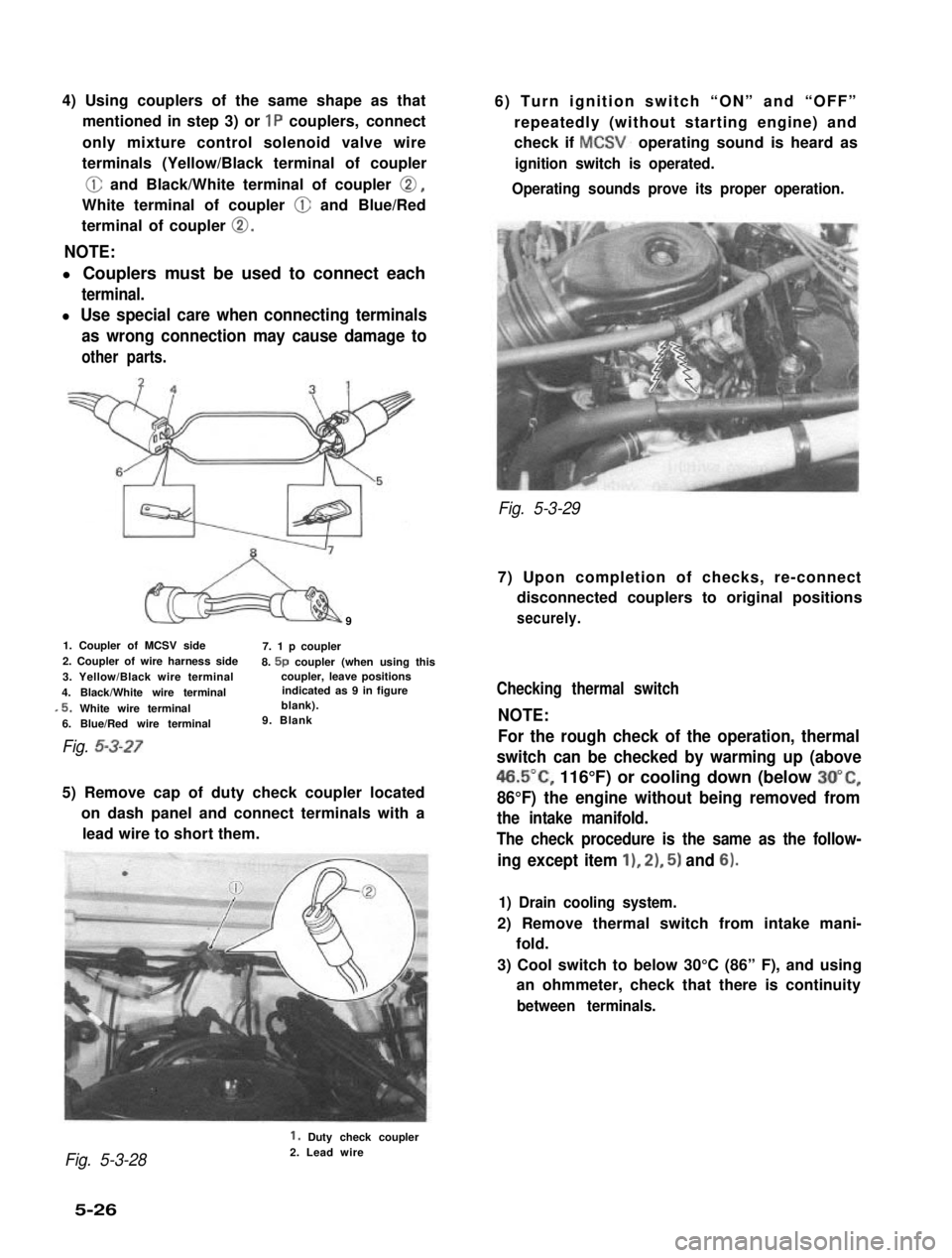
4) Using couplers of the same shape as that
mentioned in step 3) or 1P couplers, connect
only mixture control solenoid valve wire
terminals (Yellow/Black terminal of coupler
@ and Black/White terminal of coupler 0,
White terminal of coupler @ and Blue/Red
terminal of coupler 0.
NOTE:
l Couplers must be used to connect each
terminal.
l Use special care when connecting terminals
as wrong connection may cause damage to
other parts.
9
1. Coupler of MCSV side7. 1 p coupler2. Coupler of wire harness side8. 5p coupler (when using this3. Yellow/Black wire terminalcoupler, leave positions
4. Black/White wire terminalindicated as 9 in figure
,5. White wire terminalblank).
6. Blue/Red wire terminal9. Blank
Fig. 5-3-27
5) Remove cap of duty check coupler located
on dash panel and connect terminals with a
lead wire to short them.
6) Turn ignition switch “ON” and “OFF”
repeatedly (without starting engine) and
check if MCSV. operating sound is heard as
ignition switch is operated.
Operating sounds prove its proper operation.
Fig. 5-3-29
7) Upon completion of checks, re-connect
disconnected couplers to original positions
securely.
Checking thermal switch
NOTE:
For the rough check of the operation, thermal
switch can be checked by warming up (above
46.5”C, 116°F) or cooling down (below 3O”C,
86°F) the engine without being removed from
the intake manifold.
The check procedure is the same as the follow-
ing except item 11, 21, 5) and 6).
1) Drain cooling system.
2) Remove thermal switch from intake mani-
fold.
3) Cool switch to below 30°C (86” F), and using
an ohmmeter, check that there is continuity
between terminals.
Fig. 5-3-28
1. Duty check coupler2. Lead wire
5-26
Page 178 of 962
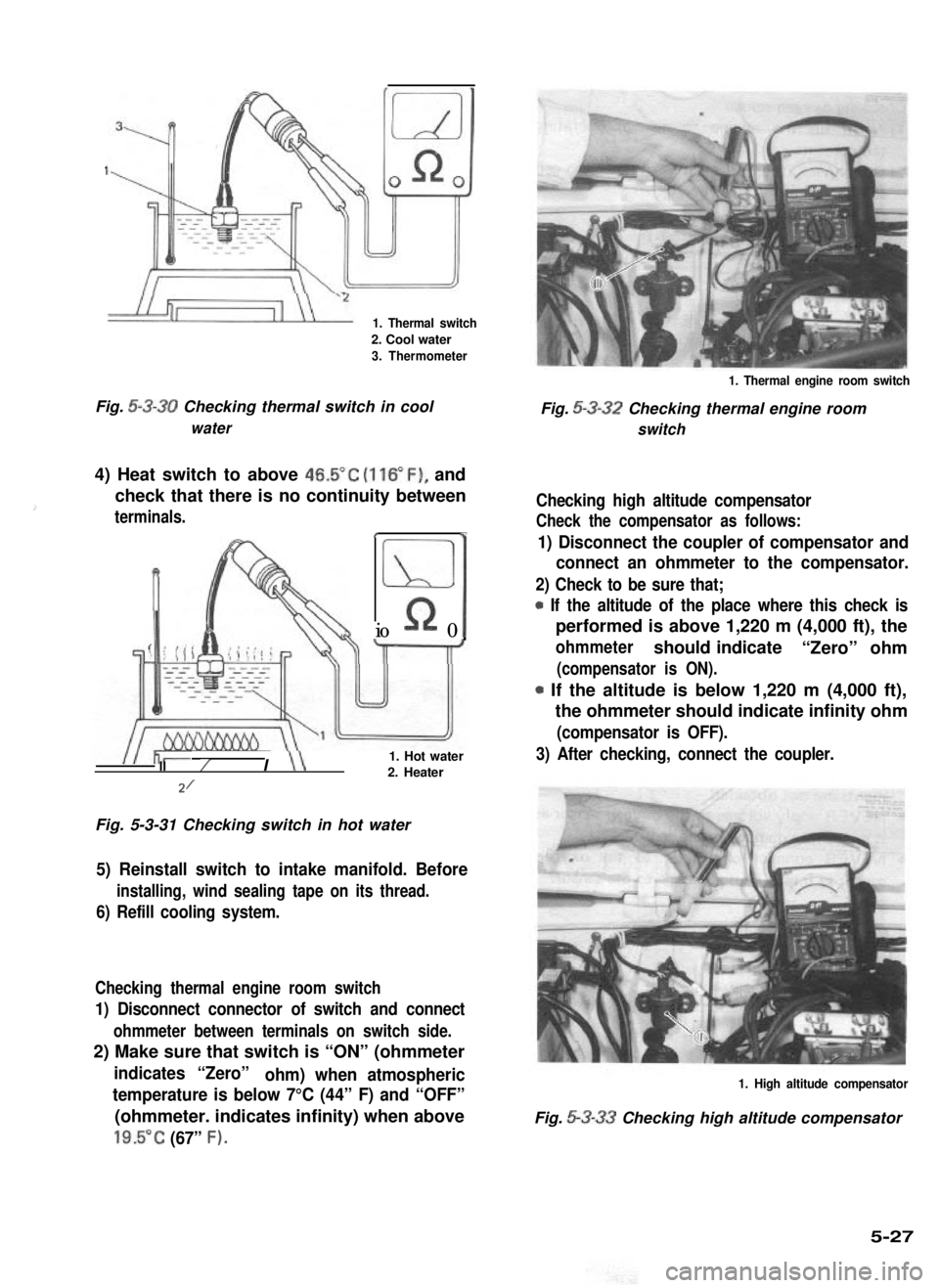
1
1. Thermal switch
2. Cool water
3. Thermometer
1. Thermal engine room switch
Fig. 5-3-30 Checking thermal switch in coolFig. 5-3-32 Checking thermal engine room
waterswitch
4) Heat switch to above 46.5”C (116”F), and
check that there is no continuity between
terminals.t
Ll
%I
Rio 0II
I \\1. Hot waterII/2. Heater
Fig. 5-3-31 Checking switch in hot water
5) Reinstall switch to intake manifold. Before
installing, wind sealing tape on its thread.
6) Refill cooling system.
Checking thermal engine room switch
1) Disconnect connector of switch and connect
ohmmeter between terminals on switch side.
2) Make sure that switch is “ON” (ohmmeter
indicates “Zero”ohm) when atmospheric
temperature is below 7°C (44” F) and “OFF”
(ohmmeter. indicates infinity) when above
19.5”C (67” F).
Checking high altitude compensator
Check the compensator as follows:
1) Disconnect the coupler of compensator and
connect an ohmmeter to the compensator.
2) Check to be sure that;
* If the altitude of the place where this check is
performed is above 1,220 m (4,000 ft), the
ohmmetershould indicate“Zero” ohm
(compensator is ON).
0 If the altitude is below 1,220 m (4,000 ft),
the ohmmeter should indicate infinity ohm
(compensator is OFF).
3) After checking, connect the coupler.
1. High altitude compensator
Fig. 5-3-33 Checking high altitude compensator
5-27
Page 179 of 962
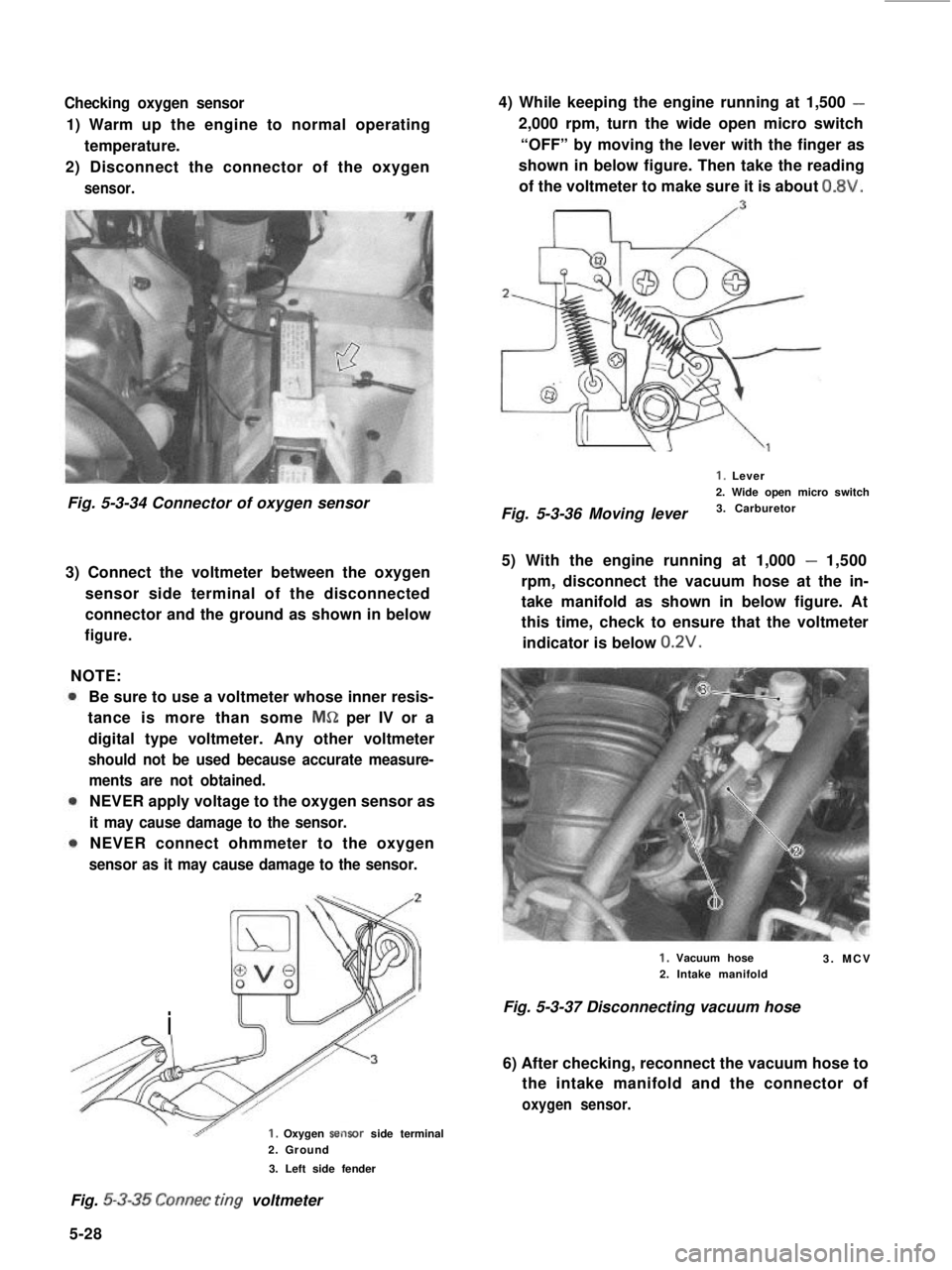
Checking oxygen sensor
1) Warm up the engine to normal operating
temperature.
2) Disconnect the connector of the oxygen
sensor.
Fig. 5-3-34 Connector of oxygen sensor
3) Connect the voltmeter between the oxygen
sensor side terminal of the disconnected
connector and the ground as shown in below
figure.
NOTE:
Be sure to use a voltmeter whose inner resis-
tance is more than some MS!Z per IV or a
digital type voltmeter. Any other voltmeter
should not be used because accurate measure-
ments are not obtained.
NEVER apply voltage to the oxygen sensor as
it may cause damage to the sensor.
NEVER connect ohmmeter to the oxygen
sensor as it may cause damage to the sensor.
i
1. Oxygen sertsor side terminal
2. Ground
3. Left side fender
4) While keeping the engine running at 1,500 -
2,000 rpm, turn the wide open micro switch
“OFF” by moving the lever with the finger as
shown in below figure. Then take the reading
of the voltmeter to make sure it is about 0.8V.
I, Lever
2. Wide open micro switch
Fig. 5-3-36 Moving lever3. Carburetor
5) With the engine running at 1,000 - 1,500
rpm, disconnect the vacuum hose at the in-
take manifold as shown in below figure. At
this time, check to ensure that the voltmeter
indicator is below 0.2V.
1. Vacuum hose
2. Intake manifold3. MCV
Fig. 5-3-37 Disconnecting vacuum hose
6) After checking, reconnect the vacuum hose to
the intake manifold and the connector of
oxygen sensor.
Fig. 5-3-35 Connec ring voltmeter
5-28
Page 180 of 962
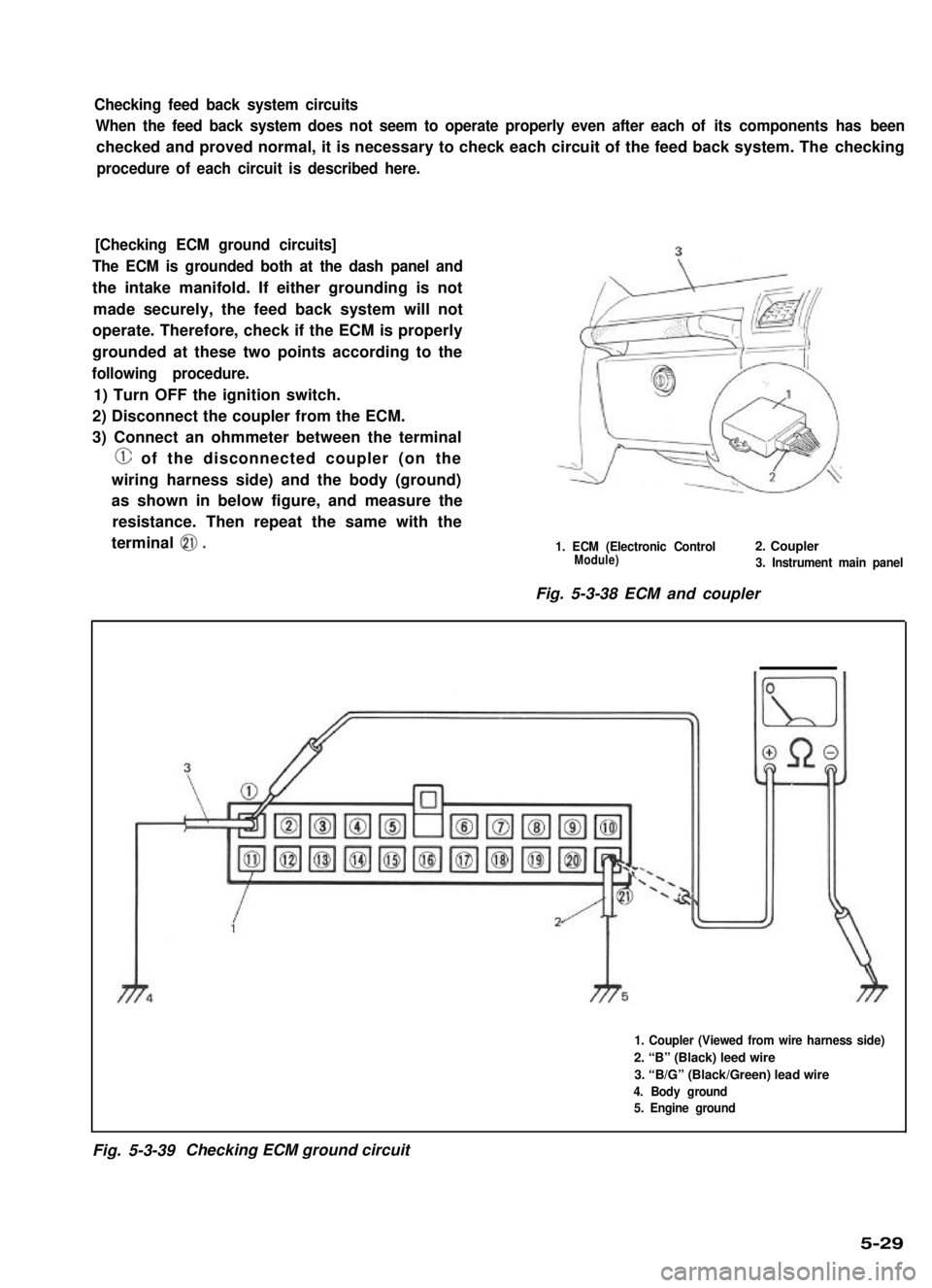
Checking feed back system circuits
When the feed back system does not seem to operate properly even after each of its components has been
checked and proved normal, it is necessary to check each circuit of the feed back system. The checking
procedure of each circuit is described here.
[Checking ECM ground circuits]
The ECM is grounded both at the dash panel and
the intake manifold. If either grounding is not
made securely, the feed back system will not
operate. Therefore, check if the ECM is properly
grounded at these two points according to the
following procedure.
1) Turn OFF the ignition switch.
2) Disconnect the coupler from the ECM.
3) Connect an ohmmeter between the terminal
@ of the disconnected coupler (on the
wiring harness side) and the body (ground)
as shown in below figure, and measure the
resistance. Then repeat the same with the
terminal 0.1. ECM (Electronic Control2. CouplerModule)3. Instrument main panel
Fig. 5-3-38 ECM and coupler
1. Coupler (Viewed from wire harness side)
2. “B” (Black) leed wire
3. “B/G” (Black/Green) lead wire
4. Body ground
5. Engine ground
Fig. 5-3-39Checking ECM ground circuit
5-29